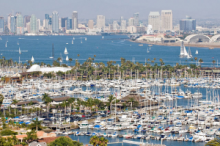Article
The second largest city in California after Los Angeles, San Diego is located at the southernmost tip of the state, on the coast of the Pacific Ocean and adjacent to the US-Mexico border. Before the arrival of the Spaniards in the 16th century, the region that is now Southern California was inhabited by a variety of indigenous peoples including the Kumeyaay, the Cahuilla, and the Cupeño. The area was first named San Miguel in 1542, but in 1602 was renamed after the Spanish monk San Diego de Alcalá de Henares. A military post and California missions were founded in San Diego in 1769, and the town grew slowly around them through the brief Mexican take-over in 1834, and the U.S. acquisition of the territory in 1846.
The city saw rapid growth in the early 1900s, when its agriculture-based economy took a significant industrial and commercial turn with the opening of the Panama Canal in 1914 and the building of aircraft plants and military complexes in the surrounding area. After World War II, the city's industry expanded further to include electronics and high tech, and both its population and land area nearly quadrupled. San Diego is known for its year-round mild climate, scenic beaches, and diverse culture. It is home to a few major universities and medical facilities, as well as famous tourist attractions such as the San Diego Zoo, Sea World, and the historic Old Town district.
"San Diego Skyline from Point Loma, July 20, 2008" by SD Dirk is licensed under CC BY.
Manuscripts
References
Encyclopedia Britannica Online
2013 San Diego. http://www.britannica.com/EBchecked/topic/521052/San-Diego,
accessed January 22, 2015.

